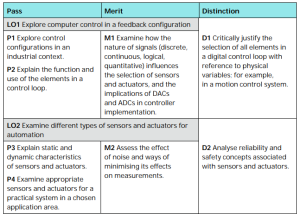- Lead Adult Care Worker Level 3 Safeguarding Assessment | Salford City College
- K/650/1144 Professional Development and Academic Writing Skills Assessment
- M26753 Mechanical Principles Assignment Brief | The Isle of Wight College
- Care Safeguiding Children Assignment | Oxford Brookes University
- PSY4011 Developmental Psychology Assessment Brief | Arden University
- QSP7PCM Professional Cost Management Assignment 2 September 2025 | UCEM
- EGR2006M Control Systems Assignment 1 Brief | University of Lincoln
- MBA7066 Innovation and Entreprenuership Assignment Portfolio 2025 | UGM
- Contract Law Assessment 2 Problem Scenario 2025-26 | University Of Salford
- Operations & Supply Chain Management Assignment Brief : E-Commerce Supply Chain Efficiency
- Unit 1 Programming Assignment 2025-26 | ESOFT Metro Campus
- K/651/4745 Unit 1 Teaching My Subject Written Assignment | Britannia Education Group
- H/650/1099 Level 4 Academic Writing and Research Skills Assignment Brief | LSBU
- ASB-4012 Codding for Business Application Assignment – Project in R | Bangor University
- Unit: Team Management in Health and Social Care OTHM Level 5 Diploma Assignment
- BTEC Level 3 Unit 4 Programming Assignment – Concepts of Programming
- HSO4004 Principles of Care Assignment-1 and Assignment-2 Semester-1 September 2025-26
- 1031ENG-N Civil Engineering Construction Technology In-Course Assessment (ICA) Group Report | Teesside University (TU)
- MOD009382 Finance and Governance in Health and Social Care 011 Assessment Coursework Report | Anglia Ruskin University
- Geotechnical Engineering Assignment 2025/26 – University Of Surrey (UniS)
Unit 5048 J/650/2990 Sensors and Automation BTEC Level 5
| Subject | Unit 5048: Sensors and Automation |
Introduction
Modern developments and applications of automation in industry rely on complex and highly reliable industrial communication networks. Industrial communication is typically a mixture of multilayered, multidimensional networks involving fieldbuses, software packages, media, and a host of other tools. To be able to install, commission, maintain and troubleshoot an industrial plant, a competent engineer requires a good understanding of sensor and actuator technologies and core communication technologies. This unit equips students with the requisite knowledge of sensors and actuators and the key skills underpinning popular industrial communication networks, such as PROFINET, Ethernet IP, Modbus, IO Link and EtherCAT, thereby extending the breadth of employment to which students pursuing a career in network technologies can aspire.
Thus, this unit aims to provide students with the skills and competencies required to work in the areas of industrial computer control, automation, and Industry 4.0. Fundamental concepts underpinning the use of sensors and industrial communication networks for automation are introduced, and students are given the essential knowledge and skills required for the use of Ethernet-based technology in support of real-time industrial network environments. An appreciation of technologies using wire pairs, fibre optics, satellites and microwave transmission will be provided.
The unit will provide specialist knowledge for work with industrial controllers (e.g. programmable logic controllers (PLCs)) in the areas of manufacturing and automation using popular network technologies such as PROFINET, together with an appreciation of security aspects in relation to network- and cloud-based solutions.
On successful completion of this unit, students will have gained knowledge and skills in the application of PLCs to industrial control, and the design, development and evaluation of Ethernet-based communication and automation systems. Through appropriate tasks and assignments, students will be exposed to good engineering practices in software engineering, and in the installation, testing and maintenance of networked automation systems.
Learning Outcomes
By the end of this unit, students will be able to:
LO1 Explore computer control in a feedback configuration
LO2 Examine different types of sensors and actuators for automation
LO3 Demonstrate design and implementation skills in programming PLC-based devices
LO4 Investigate the PROFINET standard and PROFINET operations and data analysis techniques.
Do You Need Assignment of This Question
Essential Content
LO1 Explore computer control in a feedback configuration
Types of control systems:
- Industrial control systems
- Continuous-time and discrete control
- Types of controllers – continuous, discrete and logical
- Applications of different types control systems in chosen occupation/sector (e.g., space, aeronautical, mechanical, manufacturing etc.).
Control configurations:
- Open-loop systems
- Closed-loop systems
- Feedback, feedforward and cascade loops.
Control-loop elements:
- Essential components in a control loop
- Sensors and actuators – definition and examples
- Data acquisition, roles of analogue-to-digital converter (ADC) and digital-to-analogue converter (DAC).
LO2 Examine different types of sensors and actuators for automation
Overview of measurement concepts:
- Physical process variables: static and dynamic characteristics
- Signals and noise in measurements.
Sensors for automation:
- Measurement of physical quantities: typical sensors to measure temperature, pressure, flow, speed, position, and so on
- Concepts of range, calibration, precision, reliability, limitations and appropriate use, and so on.
Actuators for automation:
- Common actuators, characteristics and uses – valves, servomotors, and so on; control and safety concepts.
LO3 Demonstrate design and implementation skills in programming PLC-based devices
Programmable logic controllers (PLCs):
- Architecture, operation, scan cycle, inputs and outputs
- CPU, input and output modules, addressing convention
- Examples of industrial application (e.g. satellite and microwave transmission, avionics systems for remote sensing, geophysical multisensor system, microsensors, electronic and optical actuation, bespoke PLC network products).
Programming for PLCs:
- Programming using IEC 61131-3 standard languages such as ladder diagrams, function block diagrams, continuous function charts, structured text and sequential function charts
- Project configuration, program organisation units (POUs), tasks
- Application development using software environments; for example, human–machine interface (HMI) design using CODESYS and Siemens S7 PLCs
- Network automation applications and related tools and platforms.
Skills and competencies:
- Industrial computer control, automation, Industry 4.0 and beyond
- Integration of automation and digital systems, and impact on organisations.
LO4 Investigate the PROFINET standard and PROFINET operations and data analysis techniques.
Industrial communication networks:
- PROFINET, Ethernet IP, Modbus, IO Link, EtherCAT and other equivalent options
- Overview of operation and maintenance: types of network maintenance, monitoring and diagnostics; evaluation and implementation of maintenance procedures; troubleshooting methodologies, tools and techniques for networks and IT infrastructure; workforce roles such as engineering technician, network engineer, systems engineer, and relevant competencies; occupational standards to meet sector demands).
Buy Answer of This Assessment & Raise Your Grades
Overview of PROFINET systems:
- Requirements of real-time control networks
- Network topologies (e.g., bus, ring, start, tree, mesh, and hybrid) used in PROFINET networks
- The PROFINET standard
- Application areas for PROFINET networks (including organisational context, PROFINET Network Engineer roles and occupational relevance, CPD).
Design and implementation of PROFINET systems:
- PROFINET system design, protocols and principles of operation
- PROFINET installation, troubleshooting (e.g., isolate, repair and escalate faults based on data) and maintenance in the context of Industry 4.0
- Use of appropriate software and hardware tools; for example, ProfiTrace, Wireshark
- Use of cloud-based systems for maintenance and analytics.
Learning Outcomes and Assessment Criteria


Recommended Resources
Note: See HN Global for guidance on additional resources.
Print Resources
- Groover, M.P. (2020) Automation, Production Systems, and Computer-Integrated Manufacturing. 5th Ed. Addison Wesley.
- Love, J. (2007) Process Automation Handbook: A Guide to Theory and Practice. Springer-Verlag.
- Popp, M. (2015) Industrial communication with PROFINET. PROFIBUS Nutzerorganisation e.V. (PNO).
- Powell, J. and Vandelinde, H. (2015) Catching the Process Fieldbus: An introduction to PROFIBUS and PROFINET. 2nd Ed. Siemens Milltronics Process Instruments.
Websites
- http://www.profibus.com PROFIBUS & PROFINET International (PI) (General reference)
- http://www.profibusgroup.com PROFIBUS.PROFINET United Kingdom ‘All about PROFIBUS, PROFINET, IO-Link and omlox in the UK’ (General reference)
- http://www.profinews.com PROFINEWS ‘PROFINET, PROFIBUS, IO-Link, and omlox news from around the world’ (General reference)
- http://www.automation.com Automation.com ‘A subsidiary of the International Society of Automation’ (General reference)
- http://www.controleng.com Control Engineering ‘Control Engineering Magazine’ (General reference)
- http://www.controlglobal.com Control (General reference)
Are You Looking for Answer of This Assignment or Essay
Journals
Note: Example journals listed below provide a broad range of articles related to unit content and those relevant for the qualification. Staff and students are encouraged to explore these journals and any other suitable journals to support the development of academic study skills, and subject specific knowledge and skills as part of unit level delivery.
Control Engineering Practice. ISSN: 0967-0661.
IET Control Theory and Applications. ISSN: 1751-8644.
If you are facing difficulty in BTEC Level 5 Unit 5048 Sensors and Automation asignment, then you have come to the right place. Our experts provide a specially designed assignment help service for students. We are here to provide a free answer list written by experts for students, which you can read to increase your study efficiency. Hurry up and get your BTEC assignment done with high quality and AI free before the deadline.




